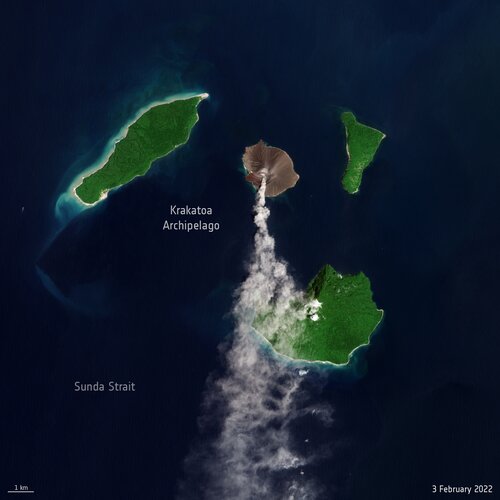
Copernical Team
Youngest pair of asteroids in solar system detected
 An international team of astronomers has discovered a pair of asteroids that split off from their parent body a mere 300 years ago. The duo is exceptional because it is the youngest known "asteroid pair" by at least a factor of ten, it passes close to Earth's orbit, and it has properties that are hard to explain given its young age.
The majority of asteroids in our solar system reside in t
An international team of astronomers has discovered a pair of asteroids that split off from their parent body a mere 300 years ago. The duo is exceptional because it is the youngest known "asteroid pair" by at least a factor of ten, it passes close to Earth's orbit, and it has properties that are hard to explain given its young age.
The majority of asteroids in our solar system reside in t Nobody Tell Elmo About Issole
 America's favorite red monster may not be interested in rocks, but Perseverance can't wait to keep exploring the rocks on Mars!
How does the rover study rocks up-close?
The Mars2020 Perseverance rover is equipped with several instruments that help it investigate the surface of Mars. The PIXL and SHERLOC spectrometers both sit on the Robotic Arm. In addition to measuring spectra and t
America's favorite red monster may not be interested in rocks, but Perseverance can't wait to keep exploring the rocks on Mars!
How does the rover study rocks up-close?
The Mars2020 Perseverance rover is equipped with several instruments that help it investigate the surface of Mars. The PIXL and SHERLOC spectrometers both sit on the Robotic Arm. In addition to measuring spectra and t Astra's planned first launch in Florida scrubbed
 The planned launch of an Astra Space rocket from Florida was scrubbed Saturday after the failure of ground equipment needed to launch.
"Unfortunately, due to a range asset that has gone out of service today, we are going to stand down from today's launch attempt of the ELaNa 41 Mission," said Carolina Grossman, director of product management at the company, during the live broadcast.
The planned launch of an Astra Space rocket from Florida was scrubbed Saturday after the failure of ground equipment needed to launch.
"Unfortunately, due to a range asset that has gone out of service today, we are going to stand down from today's launch attempt of the ELaNa 41 Mission," said Carolina Grossman, director of product management at the company, during the live broadcast. NASA, SpaceX investigate Dragon capsule parachute openings
 SpaceX and NASA officials are investigating a lag in parachute openings during the return of the company's Dragon capsules from the International Space Station with cargo and astronauts, the organizations said during a teleconference Friday.
The return of such capsules was never in jeopardy, and the landing systems performed well during 24 cargo missions and three crewed splashdowns, Sp
SpaceX and NASA officials are investigating a lag in parachute openings during the return of the company's Dragon capsules from the International Space Station with cargo and astronauts, the organizations said during a teleconference Friday.
The return of such capsules was never in jeopardy, and the landing systems performed well during 24 cargo missions and three crewed splashdowns, Sp SpaceX, NASA looking into sluggish chutes on last 2 flights

SpaceX and NASA are investigating a parachute issue that occurred on the last two capsule flights.
One of the four main parachutes was slow to inflate during the return of four astronauts to Earth last November. The same thing happened last week as a Dragon cargo capsule was bringing back science experiments from the International Space Station. In both cases, the sluggish parachute eventually opened and inflated—although more than a minute late—and the capsules splashed down safely off the Florida coast.
Officials for SpaceX and NASA said Friday they want to better understand what's happening, especially before launching another crew in a month or two. They're looking at photographs and inspecting the parachutes for clues, taking "extra caution with this very critical system," said Steve Stich, manager of NASA's commercial crew program.
"We're not taking anything for granted," SpaceX's William Gerstenmaier, a former NASA official, told reporters.
SpaceX's first private flight to the space station, with three ticket-buying businessmen and their retired astronaut escort, is set to blast off from NASA's Kennedy Space Center on March 30. NASA's next astronaut ferry flight would follow on April 15.
Asteroid sharing Earth's orbit discovered. Could it help future space missions?

Research has shown that the Earth trails an asteroid barely a kilometer across in its orbit about the Sun—only the second such body to have ever been spotted. It goes round the Sun on average two months ahead of the Earth, dancing around in front like an excited herald of our coming.
This object, known as 2020 XL₅, was first spotted in December 2020 using Pan-STARRS telescopes on the summit of Haleakala on the Hawaiian island of Maui. But determination of its orbit required follow-up observations using the 4.1-meter SOAR (Southern Astrophysical Research) telescope in Chile.
Based on this data, a team led by planetary scientist Toni Santana-Ros of the University of Alicante in Spain has now announced that 2020 XL₅ is trapped for at least the next several thousand years in an orbit about one of the Sun-Earth "Lagrange points.
Video: Webb Quest—mind-blowing mission to the early Universe
Use this form if you have come across a typo, inaccuracy or would like to send an edit request for the content on this page. For general inquiries, please use our contact form. For general feedback, use the public comments section below (please adhere to guidelines).
Please select the most appropriate category to facilitate processing of your request
NASA, NOAA to get new weather eyes in the sky with March launch from Cape Canaveral

Soon, weather scientists will have an even stronger pair of eyes in the sky once a new advanced weather satellite launches this March.
The GOES-T, short for Geostationary Operational Environmental Satellite, is aiming for liftoff March 1 from Cape Canaveral Space Force Station on a United Launch Alliance Atlas V rocket thanks to a collaboration between the National Oceanic and Atmospheric Administration and NASA along with several other partners.
GOES-T, roughly the size of a small school bus, is the third in the GOES-R series of four advanced weather satellites. The value of GOES-T isn't exactly clear as the NOAA doesn't individually price out satellites one by one, said Pam Sullivan director of the GOES-R program. However, Sullivan did say the four-part project costs $11.7 billion.
"The value is returned to us public in benefits provided," Sullivan. "The observations of these satellites is even more critical now that the U.S. is experiencing a record number of billion dollar disasters."
Last year, dry and heated conditions led to an unprecedented amount wildfires in the northwest U.S. with thousands of acres burnt. Both Germany and China experienced historic flooding, and the Atlantic observed 21 named tropical systems—the third highest amount behind 2020′s 30 named storms and 2005′s 27 total.
New eruption at Krakatoa Volcano
 Image:
A new eruption started at the Anak Krakatoa volcano in Indonesia on 3 February 2022, as seen in this image captured by the Copernicus Sentinel-2 mission.
Image:
A new eruption started at the Anak Krakatoa volcano in Indonesia on 3 February 2022, as seen in this image captured by the Copernicus Sentinel-2 mission. Week in images: 31 January - 4 February 2022

Week in images: 31 January - 4 February 2022
Discover our week through the lens

